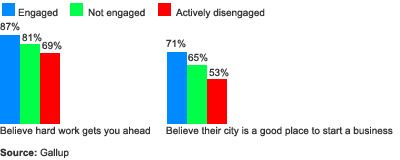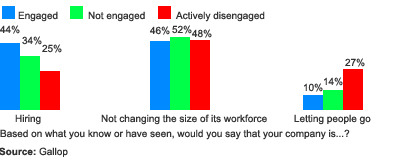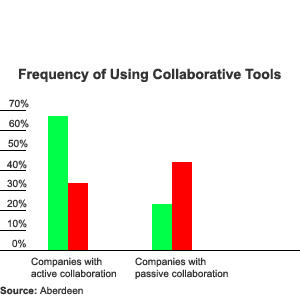Your leaders, your top performers and your most productive workers are your most engaged workers. More and more, statistics bear out this fact.
Consider these alarming facts:
- Only 13% of employees worldwide are engaged in their jobs
- Another 63% of employees are not engaged, lacking motivation
- 24% are actively disengaged, unproductive and possibly a negative influence at work1

The United States and Canada collectively have the most engaged workers compared to other regions in the study (29%)2, but it still prompts the question, how do you create a more engaged workforce? Recent research from multiple sources answers this question.
According to a 2013 survey conducted by Aberdeen Research3, leading factors driving ESC (Enterprise Social Collaboration) investments include:
- Geographic dispersement of employees (42%)
- Leadership wants to implement a more dynamic way to connect the organization (35%)
- Employees don’t know where to find information (34%)
How Do You Create a More Engaged Workforce?

Research shows that social connections and company culture play a huge role in employee engagement and satisfaction with their jobs. Here are some of the factors that rank high in recent research.4
Social Collaboration
Successful companies create open social collaboration as part of company culture and as part of work processes. This comes out in open communication, frequent feedback, and recognition for contributions to the workplace. They also make employees aware of why their work matters.
Social collaboration in a shared portal is a great way to instill engagement because employees get immediate feedback on their work, making them feel more like partners than underlings.
Appreciation for Contributions
Employee contributions large and small draw praise at companies that do engagement well also. Many companies reward a handful of salespeople with President’s Club, but the most successful companies add verbal and written recognition, monetary rewards, honors and activities.
The trend toward unified collaboration is slow though, which means leading companies have the opportunity to take a leadership role against the competition. In fact, Gartner suggests that fewer than 10% of enterprises will have completed implementing a single vendor’s complete collaboration suite by the end of 2016.5 Aberdeen Research surveyed more than 630 companies in 2013, and reports that only 21% are actively deploying ESC (Enterprise Social Collaboration) solutions.6
The Importance of Engagement

Research shows that engaged workers have a higher opinion of their companies’ success and whether their companies are hiring or laying people off [graphic 1]. This statistic shows that engagement colors workers’ attitudes. According to Aberdeen’s 2013 survey and subsequent 2014 report, 70% of best-in-class companies actively encourage employees across business roles to participate in the collaboration platform. For all other companies, only 30% actively encourage their employees to participate in the collaboration platform.
Even more importantly, engaged workers are more likely to believe that working hard pays off [graphic 2]. This is a sure sign that your employees will work hard with company success in mind if you engage them.
Finally, employees whose employees internalize the company’s branding attributes reflect both more enjoyment and more productivity. Even partners and contractors are more motivated and more productive when they internalize innovative, fun company attributes.
Flexibility and Ease of Use
Another key component that affects the adoption of an ESC is ease of use. Companies have four basic alternatives:
- Home-Grown Solutions: Home-grown solutions involve hand coding and lots of production and QA time. It’s a risky endeavor, and most smaller organizations in particular just can’t afford to build their own collaboration solution from scratch.
- Point Solutions: Companies can patch together a series of point solutions that solve individual needs, but they run the risk of building a Frankenstein. Then, if you want various systems for CRM, project management and more to talk to each other, you often need to use APIs (if they’re available) or another means to make that happen.
- Limited Functionality: There are inexpensive and even free offerings that provide ease of use, but limited functionality. So if you don’t require support for a plethora of business functions or external collaboration, perhaps you can make one of these solutions work; but you will sacrifice functionality.
- True Enterprise Collaboration: What sets this category apart is the combination of full functionality and ease of use.
The Kintone collaboration platform is a true enterprise collaboration platform. Let’s take a look at the Kintone platform and what sets it apart.
- Create Powerful Workspaces: Create an unlimited number of workspaces, and invite just the collaborators you want to each. Invite collaborators from outside your company to join the conversations, share files, submit timesheets, and be part of the team.
- Build Applications Easily: Add applications three different ways. First, add applications easily from a marketplace of pre-built applications. Second, upload a spreadsheet and convert it into an application that you can share with real-time charts and graphs. Third, build an application from scratch, but use a drag-and-drop form builder instead of hand-coding.
- Customize: No matter how you build your application, you can customize it with the drag-and-drop form builder to create new applications and solve virtually any business need. Add workflows, forms, business processes, anything, and add your applications to specific workspaces of your choosing.
Click images for a larger view.
Customer Success

Best practices for best-in-class companies, according to the Aberdeen report, include:
- 67% of best-in-class companies enable project team members to update other members about the status of a customer case from with the collaboration portal (43% for others)
- 63% of best-in-class companies provide the ability to view/show conversation history associated with a piece of content or document (38% for others)
- 50% of best-in-class companies make customer feedback details available to multiple organizational stakeholders (22% for others)

Of course, best practices are only best practices when they succeed. Consider how best-in-class companies using an enterprise social collaboration platform outperform their peers:
- Customer Retention Rate: 75% best-in-class, 63% all others
- Year-Over-Year Improvement in Response Time to Customer Requests: 16.8% best-in-class, 7.2% all others
- Year-Over-Year Improvements in One-Time Projects for Customers: 12.9% best-in-class, 6.6% all others
As a user of our own Kintone enterprise collaboration system, we’re seeing great results from our customers. Our customers are seeing a mix of improved productivity and better buy-in and engagement across their organizations. In fact, some of our customers are running their businesses on Kintone. Michael Callahan & Associates is a prime example.
Collaboration Platform: Zendesk – Customer service software provider Zendesk uses Kintone to enable collaboration across departments and around the world, and inspires collaboration through its ease of use and user experience. “My leadership team and I use Kintone to collaborate on all those topics –sharing data, sharing information, and asking each other questions,” notes Mindy Lieberman, Vice President of IT at zendesk. “It’s all in one place, it’s all centralized, and we find it really easy and fun.”
External Collaboration: BeyondSoft - BeyondSoft is a global technical staffing company, and its Silicon Valley branch is using Kintone to handle internal processes and its external collaborations. “I really see opportunities to interact with our external clients in sharing documents and workflow processes for tracking invoices, timesheets, things of that nature,” says Branch Manager Andrew Moy. With Kintone, BeyondSoft advanced from manual processes using Excel spreadsheets to automated processes that Moy says included the characteristics he sought: easy and low-cost implementation, low-cost maintenance, no training, and deep analytics.
All-in-One Business Solution: Michael Callahan & Associates - Callahan & Associates, a Virginia-based CPA firm, uses Kintone to run a paperless office and to run all of its key internal and processes. “We use Kintone all day every day, whether it’s tracking our staff members’ time on a client-by-client basis in order to really tell the profitability that we really have on each client,” explains owner Michael Callahan. “We use it for project management, so that every staff member knows what each other is doing, as well as process management, to pass different tasks on to manager level and back to staff level.”
The availability of information is important even beyond traditional information roles and industries. For instance, at Chez JT Restaurant in Mountain View, California, owner George Aviet notes that the Kintone collaboration system enables his staff to customize each diner’s experience.
“To create the environment of evening for clients, it’s important to know their evening’s desire or their dietary restriction or where they come from, how many times they’ve been in our restaurant, and what their needs are,” Aviet says. “Are they celebrating an anniversary? Are they celebrating a birthday? Are they celebrating something special? It’s really important to have a tool that gives us all that information.”
Enterprise-Ready Functionality and Security
At its Portals, Content and Collaboration Summit in early May, Gartner Research analysts confirmed their opinion that Kintone is enterprise ready. The Kintone platform is a collaboration and productivity system, a project management tool, customer service system, HR, and much more. In fact, using the Kintone formbuilder, you can build applications to accomplish virtually anything.
Give your CIO security across Marketing, Customer Service, IT, Engineering and more. Some large enterprises have been reticent to adopt cloud services, citing security concerns, but Kintone provides enterprise-level security to rival any client-server system with the client-server inefficiencies:
- Audit logging
- Two-factor authentication for PC, laptop, tablet, iPhone and Andriod devices access
- ISMS (Information Security Management System)-standard certification
- Real-time full backup across multiple data centers
The Kintone Way
Customers of Kintone collaborate in portals where they share information, files and ideas in real time from anywhere. Teams work together without the confusion of email exchanges and paper overload. Users can even create guest spaces where they can collaborate with both colleagues and external partners and clients.
Collaboration helps to make work fast and efficient; it also makes work fun. Our customers report that this collaborative environment makes engages participants worldwide.
Other engagement factors that Kintone customers report include:
- Quick start with no training and almost no time to productivity
- Ease of use that makes customization easy
- Control of data
- Process management including external participants
- Ability to optimize use of any company’s most important asset, its talent
Visit Kintone.com and get a free trial.
About Kintone
Cybozu has continuously provided web-based collaborative software since its founding in 1997. Making “Fast, Easy and Entertaining” our core values, we have strived for 16+ years to deliver easy-to-build and user-friendly enterprise systems and services to remove obstacles and bring big smiles to businesses all over the world.
1 Gallup: Worldwide, 13% of Employees Are Engaged at Work, 2013
2 Gallup: State of the Global Workplace Report 2013, 2013
3 Aberdeen Research: Enterprise Social Collaboration: Driving Customer Experience Excellence Through Teamwork, 2014
4 Forbes: How the Best Places to Work Are Nailing Employee Engagement, 2013
5 http://Kintone.tumblr.com/post/86164148874/the-Kintone-way-creating-a-culture-of-collaboration?utm_source=social&utm_medium=twitter&utm_campaign=blogttp://bit.ly/1jvAAGk Gartner: Unified Communications and Collaboration: Driving Business Value, 2013
6 Aberdeen Research: Enterprise Social Collaboration: Driving Customer Experience Excellence Through Teamwork, 2014











